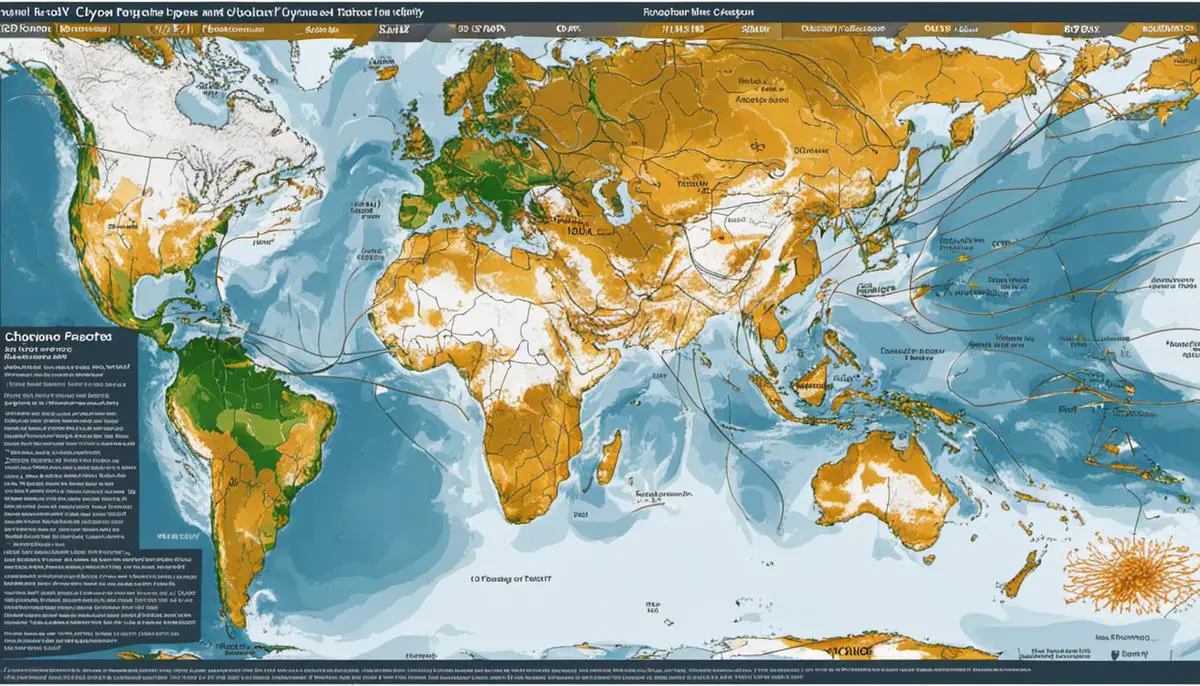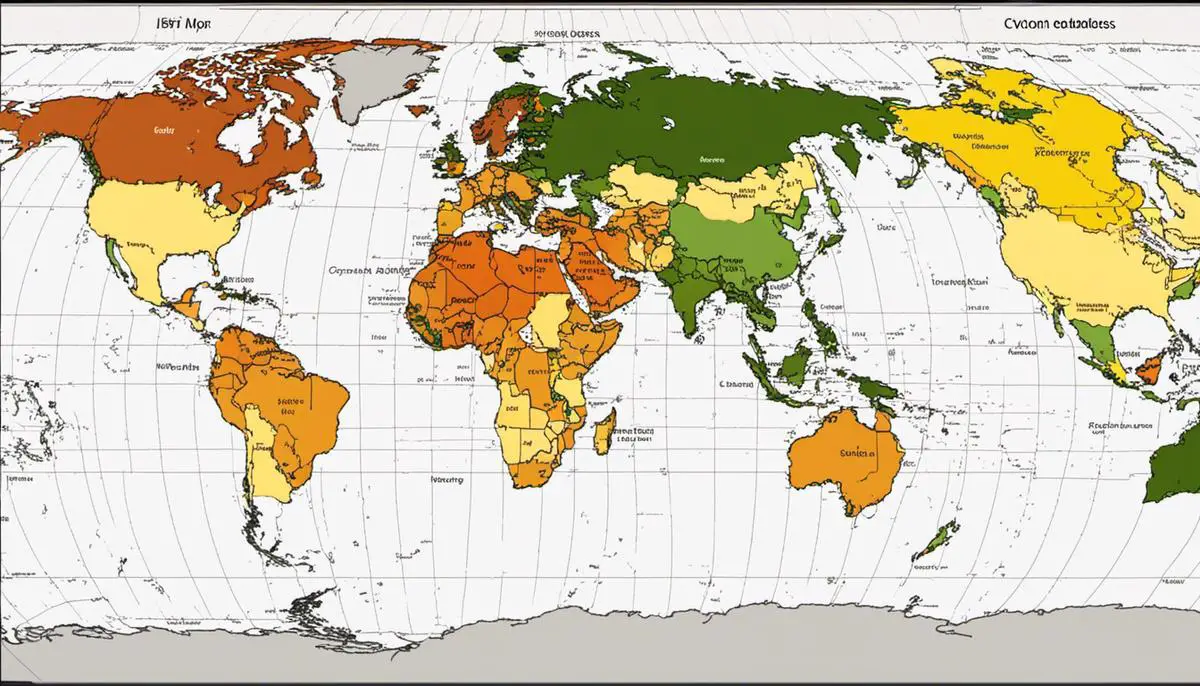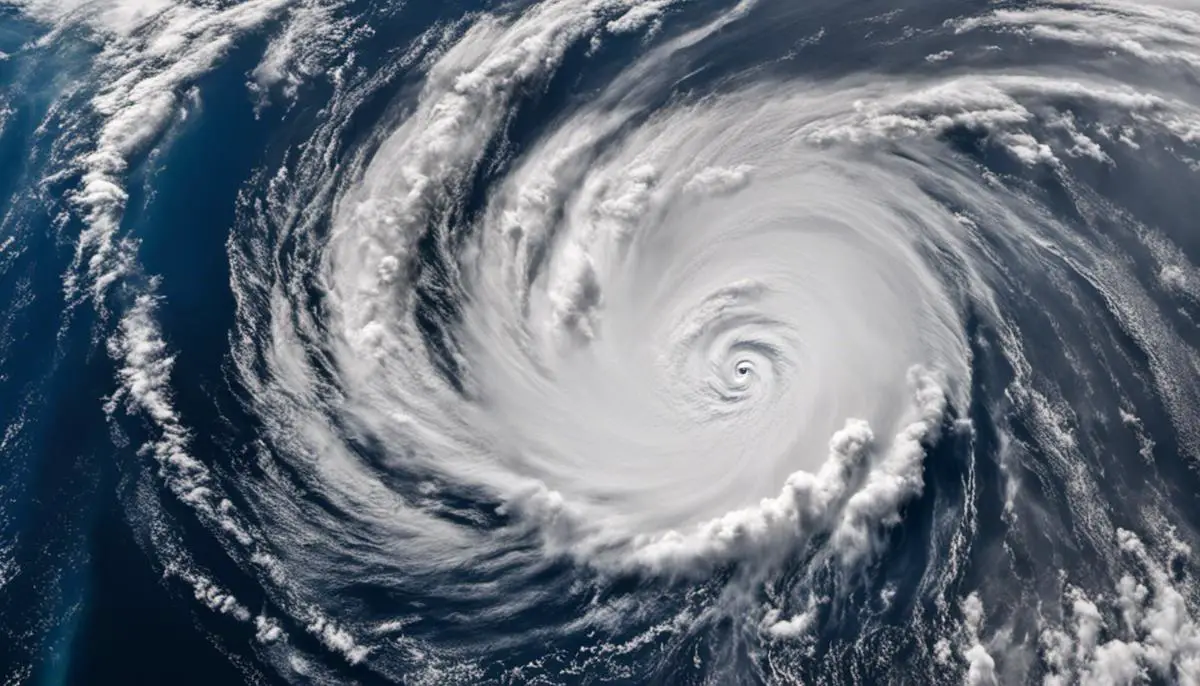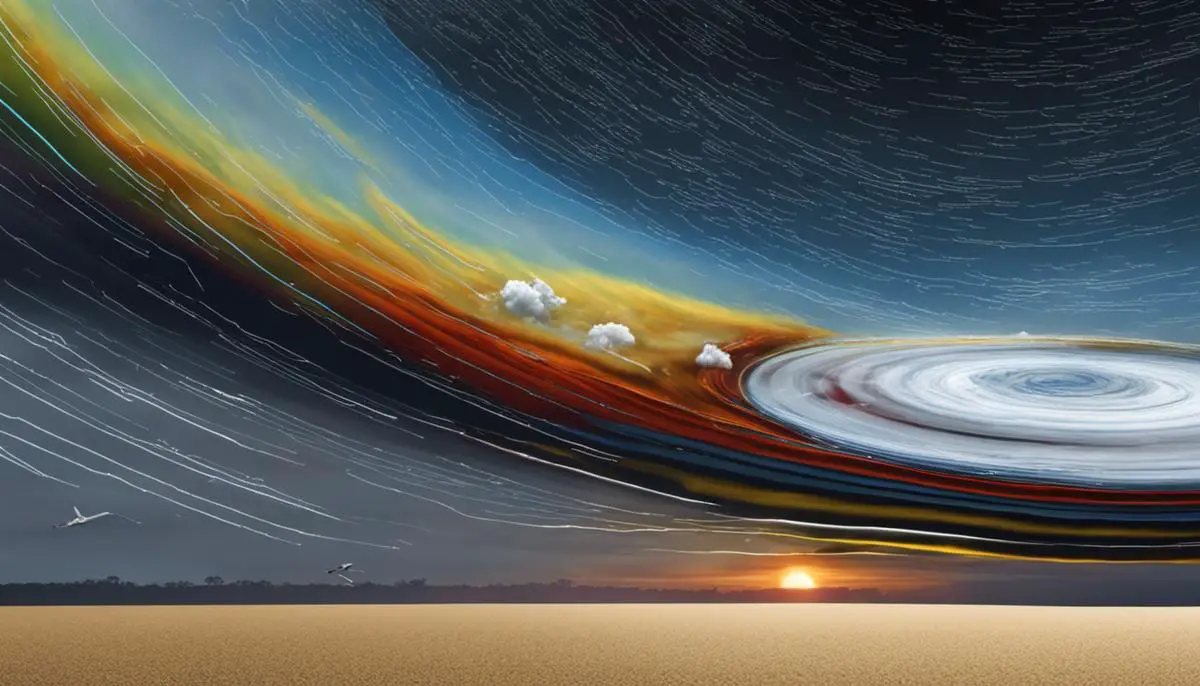In an era of rapidly changing global climates, acquiring comprehensive knowledge about cyclones—their creation, patterns, and probabilities—becomes more than an academic exercise. This understanding can provide a guiding lens for governments, organizations, and individuals alike to construct robust strategies to manage and mitigate their potential impacts. The upcoming discourse aims to decipher the science behind cyclones, scrutinizes the trends from the past, deliberates on the impacts of current climatic oscillations, and projects probabilities for cyclone occurrences in 2023. Furthermore, the text endeavors to contextualize these probabilities region-wise, presenting a more localized perspective of possible threats in 2023.
Understanding Cyclones
Understanding Cyclones: Fundamental Insights
Cyclones are rotating storm systems that are characterized by a low-pressure center, strong winds, and spiral arrangements of thunderstorms causing heavy rainfall. They usually form over large water bodies, like oceans and seas. These meteorological events are classified based on their location and intensity. For example, in the Atlantic and Northeast Pacific, they are called hurricanes, while in the Northwest Pacific, they are termed typhoons.
Cyclones originate from disturbances in the atmosphere over warm ocean waters, particularly in the earth’s tropical belt. This happens when the sea-surface temperatures are approximately 26.5 degrees Celsius or higher, usually during the summer and fall months. Moist, warm air over the ocean rises and creates a vacuum below, which is then filled by the surrounding air rushing in. The new air then gets warm and moist and rises too, causing the cycle to repeat and eventually forming a systematic pattern of cyclone winds.
In terms of cyclone formation, there are various conditions needed: warm sea temperatures, high humidity in the lower to middle levels of the atmosphere, the presence of a pre-existing weather disturbance, low wind shear, and a sufficient distance from the equator. When these conditions are met, a cyclone can evolve and intensify.
Factors Contributing to Cyclone Formation
Among the factors contributing to cyclone formation, sea surface temperature (SST) is a leading influencer. Warming ocean waters provide more energy and moisture to the air above it, potentially leading to more powerful cyclones.
Atmospheric conditions, including a humid middle atmosphere and an unstable column of air, enable the development and sustenance of the cyclone system. A pre-existing disturbance helps kick-start the cyclone, providing an initial circulation and upward motion of the air.
The location and timing also matter. For instance, cyclones tend not to develop near the equator due to the earth’s rotation’s effect on the atmosphere, specifically the Coriolis Force, which is minimal at the equator. Cyclones are more likely to form during the warm season, when ocean temperatures are at their highest.
Decoding the Probabilities of 2023 Cyclones
Predicting the cyclone probabilities in a particular year like 2023 involves a deep dive into numerous detailed analyses that includes different methodologies and datasets. Proficient meteorologists and climate scientists use data from past climate records, contemporary oceanic and atmospheric statuses, and highly developed computer models to formulate these forecasts.
As we get closer to 2023, accurate cyclone projections will be disseminated to the public. They will be frequently adjusted as the states of the ocean and atmosphere change. Considering climate change’s role in raising sea temperatures and other varying elements, it’s not too far-fetched to presume that there may be an upsurge in the likelihood of cyclone occurrences.
It’s imperative to note that cyclone projections are approximate calculations, relying on the optimal scientific data and simulation techniques available. Nevertheless, the precise coordination of individual cyclone events’ timing, place, and severity continues to pose a significant challenge for distant predictions, highlighting the ongoing necessity for public alertness, readiness, and an advancement in prediction technology.

Historical Cyclone Patterns
Historical Review of Cyclone Patterns
Characteristically associated with drenching rain and powerful winds, cyclones play a significant role in dictating weather patterns on a global scale. The regularity and potency of these natural occurrences have demonstrated an evolution over time. Through records provided by the National Oceanic and Atmospheric Administration (NOAA), we observe a discernible surge in the frequency and intensity of cyclones during the last 100 years.
This escalation seems to be coupled strongly with the broader narrative of global climate change. With the planet experiencing warming trends, the conducive conditions for cyclone genesis are appearing more regularly. Specifically, the rise in sea surface temperatures, especially in the Atlantic and Pacific regions, has created a more favorable environment for cyclone development. In fact, over the past few decades, more cyclones have risen to be classified as ‘major’, reaching category 3 or above in strength.
Analysing Trends and Frequency Over the Years
Since 1970, there has been a steady increase in the frequency of cyclones. In particular, the first two decades of the 21st century have seen a significant jump. A clear trend that emerges from this analysis is that warmer years tend to have higher cyclone activity.
The decade from 1990 to 2000 saw an average of 11.3 cyclones per year, with only 2 of those reaching Category 3 or higher. The following decade, 2000 to 2010, saw an increase in both overall cyclone frequency, with an average of 12.1 per year, and the number that reached ‘major’ status, with an average of 4 annually reaching category 3 or above. Between 2010 and 2020, this trend continued, with an average of 13.5 per year, and 4.6 achieving ‘major’ status.
Forecasting 2023’s Cyclone Activity based on Historical Trends
By analyzing cyclone trends from past decades, scientists can project an informed estimate of potential cyclone activity for 2023. Predictive models built on this historical data suggest increasing cyclone frequency and severity, primarily attributed to a generally warmer global climate.
Assuming our global climate change efforts and existing temperature anomalies continue on the current path, the year 2023 might follow this pattern of increased cyclone activity. Current climate models predict approximately 14-15 cyclones for 2023, with a higher chance of experiencing severe or ‘major’ cyclones.
However, cyclone prediction is a complex process affected by multiple factors — not only global warming. Other weather phenomena such as El Niño and La Niña also influence cyclone development. As such, despite the projected higher likelihood of cyclones in 2023 based on the current climate scenario, actual events might deviate.

Current Climate Changes And Their Impact
Understanding the Impact of Contemporary Climate Change on Cyclone Activity
Rising global temperatures, attributed to heightened greenhouse gas levels, are driving noticeable changes on Earth, including an apparent increase in cyclone frequency and intensity.
A shocking 90% of surplus heat trapped by these gases is absorbed by the oceans, causing sea surface temperatures to soar. This leads to optimal conditions for tropical cyclone formation — warmer waters can stimulate cyclones more easily, potentially escalating wind speeds and increasing rainfall volumes — ultimately resulting in more devastating cyclones.
Link Between Warming Waters and Cyclones
Warm ocean water is a key ingredient for cyclone formation, and as sea surface temperatures continue to increase, the likelihood of cyclones can correspondingly rise. Aside from providing the energy cyclones need to form, higher ocean temperatures also cause more water to evaporate, adding to the moisture available for the storm. More moisture can lead to higher rainfall totals and worsening flood scenarios when tropical cyclones make landfall.
Other Climate Factors
However, the rise in global temperatures is not the only climate factor that affects cyclone formation and intensity. Changes in atmospheric conditions, including wind patterns and air pressure, also play significant roles. Modified wind patterns can help cyclones move across the oceans more efficiently and cover greater distances, potentially impacting land areas that previously saw fewer such events.
Looking Ahead to 2023: Cyclone Probabilities
Forecasting cyclones years ahead is a complex science full of uncertainties. Yet, emerging trends point to a possible increase in frequency and intensity of these storm events due to changes in our climate. By 2023, experts suggest that the warming of ocean temperatures and shifts in atmospheric conditions could lead to an escalation in cyclone activity.
Future climate scenarios are being modelled by scientists to further understand weather patterns, such as cyclones prevalence. Current models suggest that while the total count of cyclones might remain steady or see a marginal dip, there might be a rise in severe (Category 4 and 5) storms. This could be a viable prediction for 2023.
Regardless of the uncertainties attached to these predictions, the link between climate change and cyclone probabilities is definite. An increased risk of cyclones could lead to hazardous consequences for coastal communities, especially given the threat of rising sea levels causing extensive flooding during cyclone occurrences. Now, more than ever, informed preparation and active steps towards climate change mitigation are crucial to protect and sustain these vulnerable areas.

Predictive Models for 2023 Cyclone Probabilities
Cyclones Deconstructed: Predictive Models and their Role
Cyclones, or hurricanes and typhoons as they are known in different parts of the world, are massive atmospheric disturbances that carry with them the potential for widespread destruction. The leaps in technological advancement over recent years have brought about improved computational models and sophisticated data gathering methods, allowing analysts to predict these phenomena with increasing accuracy.
Predicting 2023 Cyclone Probabilities Through Scientific Models
Given the complexity involved in predicting cyclones, there are several scientific models that scientists utilize to predict their likelihood. The models consider various factors and variables such as sea surface temperatures, wind patterns, atmospheric pressure, and others. These models, like the Geophysical Fluid Dynamics Laboratory (GFDL) Model, the European Centre for Medium-Range Weather Forecasts (ECMWF) model, or the United Kingdom Met Office (UKMET) model, are examples of powerful forecasting tools utilized in the prediction of cyclone activity.
Predictive models for 2023 cyclone probabilities run computational simulations based on historical weather data and current climatic conditions, largely driven by sea surface temperatures and atmospheric patterns. The higher the sea surface temperature, the larger the potential for cyclones to form and intensify. Also, the phase of major climate oscillations, such as El Niño and La Niña, affect the seasonal tropical cyclone activity. La Niña often results in more active hurricane seasons in the Atlantic, while El Niño tends to suppress them.
Factors Considered in Cyclone Predictive Models
When formulating cyclone probabilities, numerous factors come into play. Attention is given to upper-level wind patterns and vertical wind shear that can impact the formation and steering of cyclones. Atmospheric humidity levels are also crucial as drier atmospheric conditions can hinder cyclone development while moisture-rich environments can encourage it. Furthermore, long-term climate patterns such as Atlantic Multi-decadal Oscillation (AMO) and Pacific Decadal Oscillation (PDO) significantly alter the cyclone activity in the long term.
The Role of Global Warming and Climate Change
It is also important to mention the role of global warming and climate change in cyclone probability predictions. While it is challenging to attribute a single cyclone event to climate change, an increasing trend of powerful and destructive cyclones is linked to the changing climate. As global temperatures continue to rise, it is expected that the intensity and rainfall rates of cyclones might increase, even though the overall frequency might not drastically change. Therefore, predictions made for 2023 cyclone probabilities and beyond are also taking climate change projections into account.
The predictions for 2023 cyclone probabilities depend heavily on access to high-quality worldwide observational data combined with the continuous improvements in numerical weather prediction models. As our climate changes, our ability to predict future cyclone possibilities will become even more critical, making ongoing research and advancements in this field both valuable and necessary.

Regions And Their Probable Risk Levels
Understanding Regional Cyclone Probabilities for 2023
Factors shaping 2023’s cyclone pathways and their likelihoods are diverse and influenced by a host of climatic elements. When forecasting, meteorologists typically divide the world into specific regions, tailoring their predictions according to localized environmental conditions. Each region harbors a unique mix of factors like ocean currents, wind patterns, and temperature gradients that all play a role in shaping the probable development of cyclones.
Atlantic Region: Expected High Risk
The Atlantic region, which includes the Caribbean Sea and Gulf of Mexico, encompasses areas highly prone to hurricanes. The Atlantic hurricane season of 2023 is projected to experience an above-average cyclone count. This conclusion arises from the active cyclical Atlantic Multi-Decadal Oscillation (AMO), which warms the Atlantic Ocean, enabling cyclone formation.
Eastern and Central Pacific Region: Medium to High Risk
The Eastern and Central Pacific region, a notorious area for cyclone and hurricane formation, has a variable cyclone probability in 2023. This region’s cyclone activity is driven by the El Nino Southern Oscillation cycle (ENSO). However, predicting the phase of ENSO (El Nino or La Nina) two years in advance remains challenging, rendering cyclone probabilities somewhat uncertain.
Western Pacific Region: Persistent High Risk
Typically, the Western Pacific region, including the nations of the Philippines, Taiwan, and Japan, experiences a high level of cyclone activity. The forecast carries through to 2023, with continued high risk due to warmer waters and favorable wind patterns enhancing cyclone development.
Indian Ocean: Lower Risk with High Variability
The Indian Ocean cyclone probability varies significantly year to year. While the Indian Ocean does witness cyclones, the frequency is generally less compared to the Atlantic and Pacific regions. For 2023, current forecasts point towards average to slightly below-average cyclone occurrences.
Australia and Southwestern Pacific: Moderate Risk
The Southwestern Pacific, including Australia, can expect moderate cyclone risk in 2023. This expectation is based on current warming trends in the Coral Sea and Tasman Sea, which may enhance cyclone development.
Risk Quantification
Scientific modeling provides us with the flexibility to predict regional cyclone risks up to two years ahead of time. Yet, it is crucial to understand that these probabilities are not definitive. Long term changes in climate patterns can potentially escalate or decrease the cyclone risk for a region.
These predictions essentially work as a roadmap for early readiness rather than as a precise forecast of cyclone incidents. As we navigate through the ever-changing climatic conditions, it’s our responsibility to constantly adapt to and advance our methods for predicting extreme weather events. This approach would also include the cyclone probabilities envisaged for 2023 and later years.

Preparedness and Impact Mitigation Strategies
Grasping 2023 Cyclone Probabilities
The anticipated cyclone probabilities for 2023 pivot on an in-depth analysis of long-standing cyclone patterns. A range of resources, including historical data, satellite observations, and mathematical models, plays a crucial role in concocting these predictions. It’s worth noting that climate phenomena such as La Niña and El Niño considerably influence the cyclone forecast. These trends have the power to change oceanic and atmospheric conditions, further affecting the birth and evolution of cyclones.
Government and Organizational Preparedness
In preparation for potential cyclones in 2023, government institutions and organizations globally need to establish sound disaster management mechanisms. These measures encompass early warning systems, pre-disaster planning programs, and infrastructure hardening to withstand cyclones. By collaborating with meteorological agencies to forecast cyclones accurately and timely, they can relay vital information to the public, facilitating early evacuation when necessary.
Further, investment into infrastructure improvement is critical, especially in high-risk areas for cyclone occurrence. These improvements might entail retrofitting existing buildings to be more cyclone-resistant and ensuring the robustness of power and communication lines. Governments should also prepare for post-cyclone restoration activities, including relief efforts and rebuilding strategies.
Individual Preparedness
For individuals, preparedness against cyclones is essential. Personal safety and property protection are the main objectives. This preparation involves staying informed about the latest weather warnings and updates, especially during cyclone seasons, by subscribing to weather alert systems or following relevant web and social media channels.
Preparedness also includes developing a personal cyclone plan incorporating elements such as evacuation routes, emergency contacts, and designated safe rooms within homes. At the same time, assembling an emergency kit with essential items like food, water, medicines, essential documents, and other necessities is a practical readiness strategy.
Mitigating property damage can be achieved by securing loose outdoor items that could become dangerous flying debris in a cyclone, trimming overhanging tree branches close to houses and installing cyclone shutters over windows, or using strong marine plywood covers if shutters are not available.
Climate Change and Its Impact on Cyclone Probabilities
Climate change also plays a significant role in the cyclone probabilities for 2023. Increasing sea surface temperatures augment the intensity and frequency of cyclones, creating destructive weather events. Governments, organizations, and individuals should account for the impact of climate change in their cyclone preparedness and impact mitigation strategies. Addressing climate change, in essence, necessitates a concerted effort from all stakeholders to reduce greenhouse gas emissions and to develop long-term strategies that fortify resilience against severe weather events like cyclones.

Understanding cyclone probabilities for 2023 within a framework that combines historical data, current climate changes, and complex predictive models illuminates both the bigger picture and the granular details of expected climatic hazards. Mapping out the likely geographical impact based on these analyses offers a pragmatic way to prepare and equip for such events. In the face of changing climates, a proactive approach towards potential cyclones—comprising comprehensive education, meticulous prediction, and sound mitigation strategies—emerges as invaluable. By bridging scientific understanding with practical readiness, we can better equip ourselves to mitigate the destructive potential of cyclones, achieving a more resilient and safer future for all.
![]()
